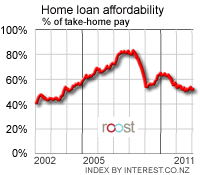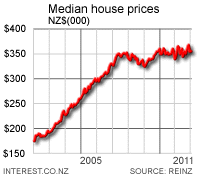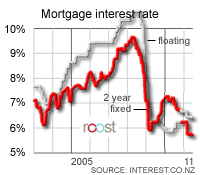 Housing affordability improved to its best level in two years in September as house prices held steady nationally and interest rates fell, the Wizard Home Loans Affordability report shows. The average 2 year fixed mortgage rate fell 34 basis points to 8.62%, while house prices fell in most of the large centres, including Auckland, Wellington and Hamilton. Tax cuts on October 1 and further falls in house prices are expected to improve affordability significantly over the rest of 2008, while interest rates are also expected to fall again after an expected cut in the Official Cash Rate on or before October 23. This monthly report measures the proportion of a single median after tax income needed in each part of New Zealand to service an 80% mortgage on the median house price in that region. It also measures that figure nationally. The Wizard Home Loans Affordability report shows it took 71.4% of the median take-home pay to service the mortgage on the median house in September, down from 73.6% in August. This is the best level of affordability since the 69.2% recorded in September 2006, but remains significantly worse than the 40-50% levels seen in 2002, 2003 and 2004 before house prices took off. "Home affordability is now improving rapidly and will get even better this month because of the October 1 tax cuts," said John Grant, Wizard Home Loans, Director, New Zealand Business.
Housing affordability improved to its best level in two years in September as house prices held steady nationally and interest rates fell, the Wizard Home Loans Affordability report shows. The average 2 year fixed mortgage rate fell 34 basis points to 8.62%, while house prices fell in most of the large centres, including Auckland, Wellington and Hamilton. Tax cuts on October 1 and further falls in house prices are expected to improve affordability significantly over the rest of 2008, while interest rates are also expected to fall again after an expected cut in the Official Cash Rate on or before October 23. This monthly report measures the proportion of a single median after tax income needed in each part of New Zealand to service an 80% mortgage on the median house price in that region. It also measures that figure nationally. The Wizard Home Loans Affordability report shows it took 71.4% of the median take-home pay to service the mortgage on the median house in September, down from 73.6% in August. This is the best level of affordability since the 69.2% recorded in September 2006, but remains significantly worse than the 40-50% levels seen in 2002, 2003 and 2004 before house prices took off. "Home affordability is now improving rapidly and will get even better this month because of the October 1 tax cuts," said John Grant, Wizard Home Loans, Director, New Zealand Business.
"It remains a buyer's market for many and the easing of the squeeze on affordability will make it easier for some to enter or re-enter the market," Grant said. "The economic outlook may be gloomy, but the silver lining is an improvement in housing affordability."  The report also shows the proportion of after tax income required for a first home buyer buying a cheaper house has improved to well below 60%. This is its best result in 2 years. A first home buyer is categorised as someone aged 25-29 that has saved 20% of their after tax income in the previous five years. The first home buyer's affordability ratio improved to 57% in September from 58.8% in August. Affordability looks set to improve through the rest of 2008 as interest rates fall at the same time as house prices keep falling. The Reserve Bank is widely expected to cut the Official Cash Rate by 50 to 100 basis points later this month. However, affordability remains very difficult for most, particularly those with single incomes and below average incomes. Most home-buyers are still forced to pool almost two median incomes to afford the mortgage on the median house, although that multiple has dropped from 2.1 in November last year to 1.79 in September. The multiple of after tax income to house prices remain well above 9, although it has reduced to levels last seen in late 2005. The multiple was around 6 and 7 in 2003 and 2004.
The report also shows the proportion of after tax income required for a first home buyer buying a cheaper house has improved to well below 60%. This is its best result in 2 years. A first home buyer is categorised as someone aged 25-29 that has saved 20% of their after tax income in the previous five years. The first home buyer's affordability ratio improved to 57% in September from 58.8% in August. Affordability looks set to improve through the rest of 2008 as interest rates fall at the same time as house prices keep falling. The Reserve Bank is widely expected to cut the Official Cash Rate by 50 to 100 basis points later this month. However, affordability remains very difficult for most, particularly those with single incomes and below average incomes. Most home-buyers are still forced to pool almost two median incomes to afford the mortgage on the median house, although that multiple has dropped from 2.1 in November last year to 1.79 in September. The multiple of after tax income to house prices remain well above 9, although it has reduced to levels last seen in late 2005. The multiple was around 6 and 7 in 2003 and 2004.  Every region reported improvements in housing affordability except Northland and Central Otago Lakes (Queenstown and Wanaka), where house prices rose in September. The biggest improvements in home loan affordability were in Auckland (down from 88.2% to 84.9%) and Wellington (down to 70.4% from 77.6%), where house prices fell 0.8% and 6.7% respectively. Southland's affordability at 44.4% remains the best in New Zealand, although it was worse than its 42.8% level seen in July. Central Otago Lakes at 112.3% remains the least affordable, although its affordability has improved from 138.9% in July. Household measure of affordability added to Wizard Home Loan Affordability reports This month a new measure of affordability has been added. Previously we have only measured affordability for a single median income or for a single first home buyer's income. Measuring household income or arriving at a definition of a "˜typical' household is very difficult, given the wide range of household types, incomes and measures of after tax income. But we have estimated affordability for one measure of a typical household that assumes a male median income and 50% of a female median income, along with the Working for Families payment associated with a 5 year old child. This measure shows that the proportion of take home pay for this "˜typical' family needed to service the mortgage on a median house is 48.2%, which is down from a peak of 54.2% in March this year, but remains above its level of 31% five years ago. How does interest.co.nz work out these numbers? Interest.co.nz gathers data from Statistics New Zealand and IRD on wages in each region, data from the Real Estate Institute from each region each month, and data from banks and non-banks on interest rates. It has calculated home loan affordability going back to the beginning of 2002. How is this survey different from the Massey University survey of affordability? The Massey study is only done quarterly rather than monthly and uses an index of Home affordability rather than actually measuring home loan affordability. It uses an index rather than the actual measure of the proportion of after tax pay needed to service an 80% mortgage on a median home. The exact composition and meaning of the index is not detailed. Why use a single median income rather than household income? It's true that most homebuyers are using a combination of one or more full or part time incomes to service their mortgage. Each household is different and may be using incomes from different sources. The best measure of average national household income is calculated officially once in every three years by Statistics New Zealand. Interest.co.nz chose to use the median income data series from IRD and Statistics NZ because it can be measured monthly and can be drilled down by region and by age. We do include a chart showing how many median incomes are required to keep mortgage payments at 40% of take home pay. It is currently around 2 median incomes. What's this new household measure of home affordability? We've attempted to measure affordability for a "˜typical' household of a working couple with one five year old child. We've assumed a single male median income and half a female median income along with the associated working for families payments. This is only one measure of household income and we acknowledge that there are many different types of households. Why is home loan affordability important? It is a useful way to work out if a housing market is overvalued. It's clear house prices stopped rising when the national affordability ratio rose above 80% or 2 median incomes to service the average home loan. It's a way of comparing affordability of housing markets with a national average and comparing housing values from one year to the next. For example, the affordability ratio in 2002 before the housing boom really took off was around 41%.
Every region reported improvements in housing affordability except Northland and Central Otago Lakes (Queenstown and Wanaka), where house prices rose in September. The biggest improvements in home loan affordability were in Auckland (down from 88.2% to 84.9%) and Wellington (down to 70.4% from 77.6%), where house prices fell 0.8% and 6.7% respectively. Southland's affordability at 44.4% remains the best in New Zealand, although it was worse than its 42.8% level seen in July. Central Otago Lakes at 112.3% remains the least affordable, although its affordability has improved from 138.9% in July. Household measure of affordability added to Wizard Home Loan Affordability reports This month a new measure of affordability has been added. Previously we have only measured affordability for a single median income or for a single first home buyer's income. Measuring household income or arriving at a definition of a "˜typical' household is very difficult, given the wide range of household types, incomes and measures of after tax income. But we have estimated affordability for one measure of a typical household that assumes a male median income and 50% of a female median income, along with the Working for Families payment associated with a 5 year old child. This measure shows that the proportion of take home pay for this "˜typical' family needed to service the mortgage on a median house is 48.2%, which is down from a peak of 54.2% in March this year, but remains above its level of 31% five years ago. How does interest.co.nz work out these numbers? Interest.co.nz gathers data from Statistics New Zealand and IRD on wages in each region, data from the Real Estate Institute from each region each month, and data from banks and non-banks on interest rates. It has calculated home loan affordability going back to the beginning of 2002. How is this survey different from the Massey University survey of affordability? The Massey study is only done quarterly rather than monthly and uses an index of Home affordability rather than actually measuring home loan affordability. It uses an index rather than the actual measure of the proportion of after tax pay needed to service an 80% mortgage on a median home. The exact composition and meaning of the index is not detailed. Why use a single median income rather than household income? It's true that most homebuyers are using a combination of one or more full or part time incomes to service their mortgage. Each household is different and may be using incomes from different sources. The best measure of average national household income is calculated officially once in every three years by Statistics New Zealand. Interest.co.nz chose to use the median income data series from IRD and Statistics NZ because it can be measured monthly and can be drilled down by region and by age. We do include a chart showing how many median incomes are required to keep mortgage payments at 40% of take home pay. It is currently around 2 median incomes. What's this new household measure of home affordability? We've attempted to measure affordability for a "˜typical' household of a working couple with one five year old child. We've assumed a single male median income and half a female median income along with the associated working for families payments. This is only one measure of household income and we acknowledge that there are many different types of households. Why is home loan affordability important? It is a useful way to work out if a housing market is overvalued. It's clear house prices stopped rising when the national affordability ratio rose above 80% or 2 median incomes to service the average home loan. It's a way of comparing affordability of housing markets with a national average and comparing housing values from one year to the next. For example, the affordability ratio in 2002 before the housing boom really took off was around 41%.

We welcome your comments below. If you are not already registered, please register to comment.
Remember we welcome robust, respectful and insightful debate. We don't welcome abusive or defamatory comments and will de-register those repeatedly making such comments. Our current comment policy is here.